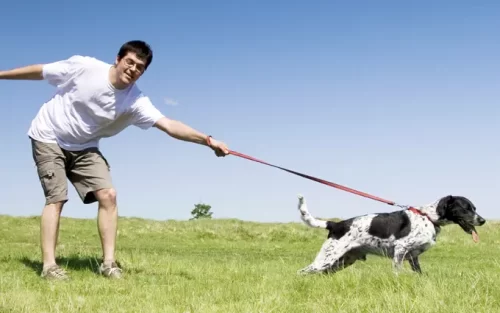Once you have found your new furry friend, whether that’s through dog adoption or a new litter of puppies, your first question may be “How do I train my dog?” Training your dog is essential for ensuring a happy, well-behaved, and safe canine companion. In this comprehensive guide, we’ll delve into various aspects of dog training, from essential commands to addressing common behavioral issues. With practical tips and easy-to-follow techniques, you’ll be well-equipped to train your dog and strengthen the bond between you both.
Why is training your dog important?
Training your dog is crucial for several reasons:
- It promotes good behavior, making your dog a more pleasant companion.
- It keeps your dog safe, ensuring they respond to commands like “come” or “stay” in potentially dangerous situations.
- It strengthens the bond between you and your dog.
- It stimulates your dog’s mind, keeping them mentally healthy.
Training your dog is essential for responsible pet ownership, offering numerous benefits that contribute to a happier and safer canine companion. Key advantages of dog training include improved behavior, safety, mental stimulation, socialization, and a stronger bond between owner and dog.
Well-trained dogs exhibit fewer unwanted behaviors, making them more enjoyable to be around and creating a more harmonious living environment. Safety is another critical aspect, as dogs that understand and consistently respond to commands are less likely to find themselves in dangerous situations.
Mental stimulation is vital for dogs’ overall well-being, and regular training sessions help keep their minds sharp and engaged. Socialization is also crucial, as a well-socialized dog is more confident and comfortable in various situations, reducing the likelihood of fear, aggression, or anxiety.
Training your dog strengthens the bond between you and your pet, fostering a deeper connection and mutual understanding. Well-trained dogs also enjoy greater freedom and flexibility in their daily lives, being more likely to be trusted in various situations, such as off-leash play or visits to dog-friendly establishments.
Investing time and effort in training your dog is not only beneficial for you and your canine companion but also contributes to the overall well-being and happiness of your entire household. By prioritizing training, you set your dog up for success, ensuring a rewarding and fulfilling relationship for years to come.
When should I start training my dog?
It’s never too early or too late to start training your dog, but the ideal time to begin varies depending on the specific context and your dog’s individual needs. However, there are some general guidelines that can help you determine the optimal time to embark on your dog training journey.
For puppies, the critical period for socialization occurs between 3 and 14 weeks of age. This time is crucial for exposing your puppy to a variety of people, animals, and environments, helping them develop confidence and adaptability. Puppy socialization classes are an excellent way to introduce your young dog to new experiences in a controlled and positive environment.
While socialization should begin as early as possible, you can start teaching basic obedience commands and manners, such as “sit” and “stay,” when your puppy is around 8 weeks old. At this age, puppies are more capable of focusing and retaining information, making it an excellent time to start laying the foundation for good behavior.
That said, it’s essential to remember that older dogs can also learn new tricks and behaviors. If you’ve adopted an adult dog or haven’t had the opportunity to train your dog during their early months, don’t be discouraged. Adult dogs can still benefit from training, although it may require more patience and consistency.
Regardless of your dog’s age, it’s vital to approach training with a positive attitude and a commitment to building a strong, trusting relationship with your canine companion. By starting training early and maintaining consistency throughout your dog’s life, you can help them become a well-behaved, confident, and adaptable member of your family.
Understanding your dog’s learning style
Just like humans, dogs have individual learning styles and preferences that can influence the effectiveness of training. By understanding and adapting to your dog’s unique learning style, you can optimize your training sessions and help them grasp new commands and behaviors more quickly.
One critical aspect to consider is your dog’s breed and natural instincts. For example, herding breeds, such as Border Collies, are highly intelligent and respond well to training that involves problem-solving and mental stimulation. On the other hand, scent hounds, like Beagles, are more motivated by their sense of smell and may respond better to training exercises that incorporate scent-based rewards.
Another factor to consider is your dog’s personality. Some dogs are highly motivated by food rewards, while others may be more driven by praise, affection, or play. Pay attention to what motivates your dog and use it to your advantage during training sessions.
It’s also essential to consider your dog’s attention span and energy level. Younger dogs and certain high-energy breeds may require shorter, more frequent training sessions to maintain focus. Be mindful of your dog’s individual needs and tailor your training approach accordingly.
In summary, understanding your dog’s learning style involves considering their breed, personality, and individual preferences. By being observant and adaptive, you can create a more effective and enjoyable training experience for both you and your canine companion.
How do I train my dog the essential commands, and what are they?
Every dog should learn the following fundamental commands:
- Sit: Teach your dog to sit calmly and stay put.
- Stay: Instruct your dog to remain in their current position until released.
- Come: Train your dog to return to you when called.
- Down: Teach your dog to lie down on command.
- Leave it: Instruct your dog to ignore or leave something alone.
- Heel: Train your dog to walk by your side without pulling on the leash.
- Off: Teach your dog to get off of furniture or people when requested.
How do I train my dog using positive reinforcement?
Positive reinforcement is an effective training method that focuses on rewarding your dog for good behavior. Here’s how to use it:
Step 1: Choose a reward
Select a reward your dog loves, such as treats, toys, or praise.
Step 2: Timing is crucial
Reward your dog immediately after they perform the desired behavior. This helps them associate the action with the reward.
Step 3: Be consistent
Consistency is key. Reward your dog every time they perform the behavior correctly.
Step 4: Gradually phase out treats
Over time, reduce the frequency of treats while still praising and rewarding your dog for good behavior.
How do I train my dog to “sit”?
Teaching your dog to sit is simple:
- Step 1: Hold a treat in front of your dog’s nose.
- Step 2: Slowly move the treat up and over your dog’s head, causing them to look up and shift their weight back.
- Step 3: As your dog’s bottom touches the ground, say “sit” and reward them with the treat and praise.
Practice this command regularly to ensure that your dog responds consistently.
How do I teach my dog the “stay” command?
Follow these steps to teach your dog to stay:
- Step 1: Put your dog in a sitting position.
- Step 2: Hold your hand up, palm facing out, and say “stay.”
- Step 3: Take a few steps back. If your dog remains in position, reward them with a treat and praise.
- Step 4: Gradually increase the distance and duration of the stay command.
Consistency and patience are crucial when teaching the “stay” command, as it may take time for your dog to grasp the concept fully.
How do I teach my dog the “come” command?
To teach your dog to come:
- Step 1: Put your dog on a long leash.
- Step 2: Step away from your dog and crouch down to their level.
- Step 3: Call your dog’s name followed by the word “come.”
- Step 4: When your dog comes to you, reward them with treats and praise.
Practice this command in various environments and with distractions to ensure a reliable response.
How do I teach my dog the “down” command?
Follow these steps to teach your dog the “down” command:
- Step 1: Hold a treat in your hand and let your dog sniff it.
- Step 2: Slowly lower the treat to the ground, guiding your dog’s nose down.
- Step 3: As your dog’s elbows and hips touch the ground, say “down” and reward them with the treat and praise.
Repeat this process regularly, and your dog will soon learn to lie down on command.
How do I teach my dog the “leave it” command?
Teaching your dog the “leave it” command involves these steps:
- Step 1: Hold a treat in your hand, keeping it concealed.
- Step 2: Present your closed fist to your dog and say “leave it.”
- Step 3: Wait for your dog to stop sniffing or pawing at your hand.
- Step 4: Once your dog looks away or loses interest, say “yes” or “good” and reward them with a different treat.
This command is particularly useful for preventing your dog from ingesting harmful substances or interacting with dangerous objects.
How do I train my dog to “heel”?
Training your dog to heel involves these steps:
- Step 1: Have your dog sit on your left side.
- Step 2: Hold a treat in your left hand and let your dog see it.
- Step 3: Begin walking and say “heel,” keeping the treat at your dog’s eye level.
- Step 4: Reward your dog with the treat and praise when they walk by your side without pulling.
Practice the heel command regularly during walks to establish a well-mannered walking routine.
How do I teach my dog the “off” command?
To teach your dog the “off” command:
- Step 1: Wait for your dog to jump on furniture or a person.
- Step 2: Say “off” and guide your dog gently off the furniture or person.
- Step 3: Once all four paws are on the ground, reward your dog with praise or a treat.
Reinforce this command consistently to teach your dog not to jump on people or furniture.
How do I train my dog to walk on a leash?
Leash training is crucial for safe and enjoyable walks. Here’s how to train your dog to walk on a leash:
- Step 1: Introduce your dog to the collar and leash, allowing them to sniff and become comfortable with it.
- Step 2: Attach the leash and start walking slowly in a controlled environment, like your backyard.
- Step 3: Reward your dog for walking close to you without pulling.
- Step 4: Introduce the “heel” command to teach your dog to walk by your side.
- Step 5: Gradually increase the duration and complexity of your walks.
Over time, your dog will learn to walk calmly on a leash without pulling or lunging.
How do I train my dog not to bark excessively?
Here are some techniques to reduce excessive barking:
- Identify and address the cause of barking, such as boredom, fear, or hunger.
- Teach the “quiet” command by rewarding your dog when they stop barking on command.
- Use distractions to refocus your dog’s attention away from the trigger.
Be consistent in discouraging unwanted barking.
Working with your dog to address excessive barking will make for a more peaceful home environment and prevent potential issues with neighbors.
How do I potty train my dog?
Potty training is essential for maintaining a clean home. Follow these steps to potty train your dog:
- Step 1: Establish a routine by taking your dog outside frequently, especially after waking up, eating, or playing.
- Step 2: Choose a designated potty spot and bring your dog there consistently.
- Step 3: Use a command like “go potty” to signal that it’s time to do their business.
- Step 4: Reward your dog with treats and praise immediately after they finish.
- Step 5: Be patient and consistent, and remember that accidents happen.
With time and consistent reinforcement, your dog will learn to eliminate outdoors and reduce accidents indoors.
How do I socialize my dog?
Proper socialization is key to raising a well-rounded dog. Follow these tips to socialize your dog:
- Expose your dog to a variety of people, animals, and environments.
- Use positive reinforcement to reward calm behavior during new experiences.
- Attend puppy socialization classes or playgroups.
- Gradually increase the complexity of social situations.
- By exposing your dog to a variety of experiences early on, you’ll help them become more confident and well-adjusted in different environments.
How do I train my dog to stop jumping on people?
To train your dog not to jump on people, follow these steps:
- Step 1: Ignore your dog when they jump on you by turning your back and avoiding eye contact.
- Step 2: Reward your dog with praise and attention when they have all four paws on the ground.
- Step 3: Teach the “sit” command and ask your dog to sit before greeting people.
- Step 4: Be consistent in reinforcing the desired behavior.
Consistency is key when teaching your dog not to jump on people. Over time, they will learn to greet others politely.
How do I address other common behavior issues?
Here are some tips for addressing other common behavior issues:
- Chewing: Provide appropriate chew toys and use a deterrent spray on furniture to discourage unwanted chewing.
- Digging: Create a designated digging area and redirect your dog to this spot when they begin to dig elsewhere.
- Separation anxiety: Gradually increase the time you spend away from your dog and provide them with mental stimulation and comfort items when you’re gone.
- Begging: Teach your dog the “place” command and have them go to a designated spot during mealtimes to discourage begging.
How can I ensure my dog’s training is successful?
Here are some tips for successful dog training:
- Be patient and consistent with your training approach.
- Set realistic expectations and remember that progress takes time.
- Use positive reinforcement to encourage desired behaviors.
- Gradually increase the difficulty of training exercises to challenge your dog.
- Seek professional guidance if necessary, such as enrolling in obedience classes or hiring a professional dog trainer.
Dog Training Classes and Professional Assistance
Dog training classes and professional assistance can provide valuable guidance and support as you embark on your dog training journey. These resources can help you learn effective techniques, address specific behavioral issues, and ensure that you and your dog are on the right track.
- Group Training Classes: Group classes are an excellent option for dogs at various stages of training, from puppies learning basic obedience to adult dogs refining their skills. These classes offer structured lessons led by experienced trainers, often in a group setting with other dogs and their owners. This environment not only provides expert instruction but also exposes your dog to new people and animals, promoting socialization.
- Private Training Sessions: If your dog requires individualized attention or struggles with specific behavioral issues, private training sessions can be highly beneficial. A professional trainer can assess your dog’s unique needs and develop a tailored training plan to address any challenges. Private sessions also allow for more in-depth instruction and personalized feedback, ensuring that both you and your dog are learning effectively.
- Board and Train Programs: For those seeking a more intensive training experience, board and train programs offer an immersive approach. In these programs, your dog stays with a professional trainer for a designated period, receiving daily training sessions tailored to their needs. This option can be particularly useful for dogs with severe behavioral issues or those requiring specialized training.
Regardless of the option you choose, professional assistance can be an invaluable resource in helping you train your dog effectively and efficiently. By leveraging expert guidance, you can ensure a successful and rewarding training experience for both you and your canine companion.
Conclusion
Training your dog is an ongoing process that requires patience, consistency, and dedication. By using positive reinforcement techniques and focusing on essential commands, you can build a strong foundation for a well-behaved and happy canine companion. Remember to always reward good behavior, gradually increase the complexity of training exercises, and provide your dog with plenty of opportunities to practice their skills.
As you progress in your training journey, consider seeking the guidance of professional dog trainers or attending group classes to further enhance your dog’s skills and socialization. By investing time and effort into training your dog, you will not only create a safer and more enjoyable living environment but also deepen the bond between you and your furry friend.



